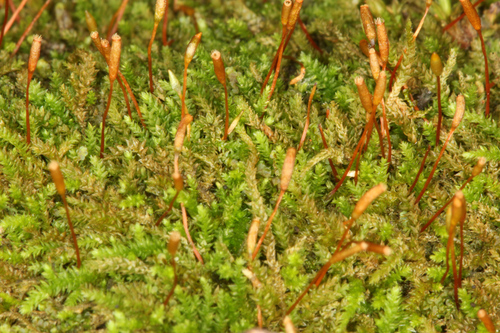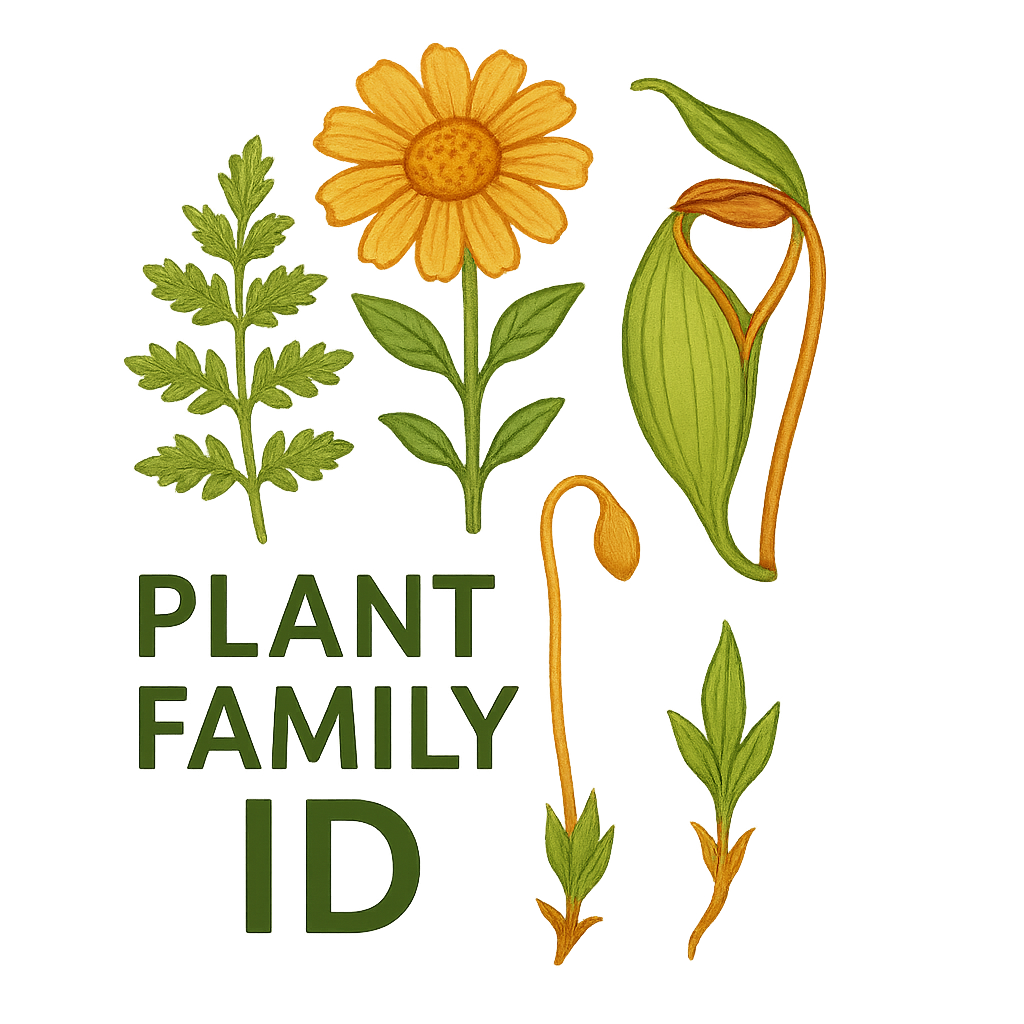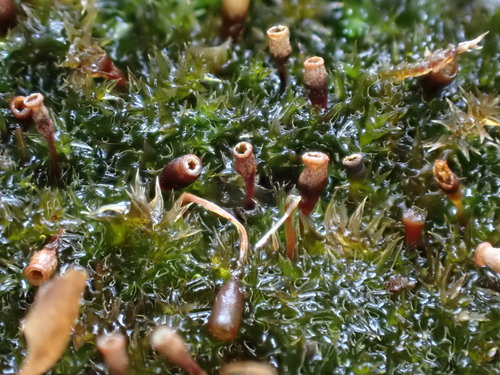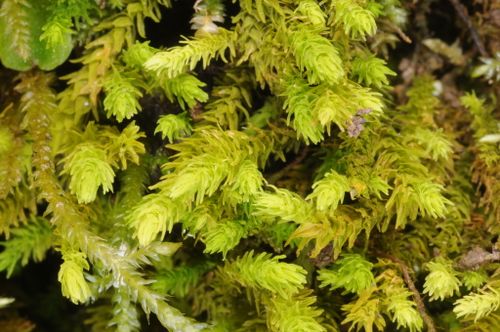Leskeaceae
Leskea Moss Family
Leskeaceae is a family of pleurocarpous mosses typically forming intricate, often dull, yellowish-green to brownish mats. They are commonly found growing on the bark of trees (epiphytic), rocks (epilithic), or soil, particularly in temperate regions and often favoring neutral to calcareous substrates. Unlike many related families, they often appear less glossy.

Overview
The Leskeaceae family is part of the large and diverse order Hypnales. It includes around 15-20 genera and roughly 150 species, though the exact circumscription can vary between classification systems. These mosses are widespread globally, but are particularly common in temperate zones of the Northern Hemisphere.
Leskeaceae are characterized by their pleurocarpous habit, often irregular branching, and leaves that typically possess a distinct, single costa (nerve) that ends below the apex. A key feature for many species, often requiring magnification, is the presence of papillae (small bumps or projections) on the leaf cells, contributing to their often dull appearance. Sporophytes commonly feature erect, symmetrical capsules, sometimes with a reduced or specialized peristome structure.
Ecologically, Leskeaceae play a role as primary colonizers on bark and rock surfaces. Their tolerance for drier conditions and sometimes calcareous substrates allows them to occupy habitats less suitable for other pleurocarpous mosses. They contribute to substrate development and provide microhabitats for small invertebrates.
Quick Facts
- Scientific Name: Leskeaceae
- Common Name: Leskea Moss Family
- Number of Genera: Approximately 15-20
- Number of Species: Approximately 150
- Distribution: Widespread, especially temperate regions worldwide, common in Northern Hemisphere.
- Evolutionary Group: Bryophytes - Mosses - Hypnales
Key Characteristics (Moss Morphology)
Gametophyte: Growth Form and Habit
Plants are pleurocarpous, typically forming low, intricate, often wiry mats that adhere closely to the substrate. They are usually small to medium-sized and often appear dull green, yellowish-green, or brownish, lacking the glossiness of many other Hypnales. Stems are creeping, with branching that is often irregular or subpinnate.
Gametophyte: Stems
Stems usually possess a central strand. Paraphyllia (small outgrowths on the stem) are present in some genera (e.g., Leskea) but absent in others. Pseudoparaphyllia are typically present at branch bases.
Gametophyte: Leaves
Stem and branch leaves are often similar. Leaves are typically erect-spreading to imbricate when dry, spreading when moist, ovate to ovate-lanceolate, often somewhat concave but not strongly so, and usually symmetrical. Leaf apices are typically acute to acuminate. Margins are often plane or recurved below, usually entire or serrulate near the apex. A defining feature is the single, relatively strong costa that usually ends well below the leaf apex. Leaf cells (laminal cells) are typically short (isodiametric, quadrate to short-rhomboidal) and often obscured by papillae (single or multiple small bumps per cell), contributing to the dull appearance. Alar cells are usually quadrate and not strongly differentiated.
Sporophyte: Seta, Capsule, and Peristome
Sexual condition varies (autoicous or dioicous). The seta is elongated, smooth or sometimes papillose. The capsule is typically exserted, often erect and symmetrical (or only slightly curved), and cylindrical to ovoid. The operculum is conical to rostrate. The peristome is double but often shows some degree of reduction compared to the typical hypnoid type; it's sometimes described as "leskeoid." The endostome segments may be narrow or poorly developed, and cilia are often rudimentary or absent.
Field Identification (Mosses)
Identifying Leskeaceae often involves observing the growth habit, leaf characteristics (especially the costa and papillae), and capsule orientation:
Primary Identification Features (Field/Hand Lens)
- Pleurocarpous growth habit: Forming intricate, often dull mats on bark or rock.
- Dull appearance: Plants typically lack the glossiness common in other pleurocarps (due to papillose cells).
- Leaf shape and costa: Ovate-lanceolate leaves with a distinct single costa ending well below the apex.
- Papillose leaf cells: Cells often appear rough or opaque under a hand lens (papillae clearly visible with a microscope).
- Erect, symmetrical capsules: If sporophytes are present, look for upright, straight capsules.
- Habitat: Frequently found on tree bark (especially base) or rocks, often in somewhat dry or calcareous sites.
Secondary Identification Features (Microscope often needed)
- Cell shape: Laminal cells typically short (isodiametric to short-rhomboidal).
- Papillae details: Confirm presence and type (single, multiple, location) of papillae on cells.
- Paraphyllia: Check stems for presence/absence of small filamentous or leaf-like paraphyllia (genus-dependent).
- Peristome structure: Examine the peristome teeth of mature capsules for signs of reduction (narrow segments, absent cilia).
Common Confusion Points (Other Moss Families)
- Thuidiaceae: Often have more regularly pinnate branching (fern-like) and abundant paraphyllia covering stems and branches. Cells are also often papillose.
- Amblystegiaceae: Many grow in wetter habitats, often have stronger costae (sometimes reaching apex), and smooth leaf cells. Capsules are often inclined or horizontal.
- Anomodontaceae: Often larger plants with leaves sometimes secund (curved to one side) or having different cell structures. Often found on bark or calcareous rock.
- Pylaisiadelphaceae: Can have similar habitats, but often differ in costa length, cell shape, alar cell development, and peristome structure.
Field Guide Quick Reference (Mosses)
Look For:
- Pleurocarpous, dull, intricate mats
- Habitat on bark/rock (often calcareous)
- Single costa ending below apex
- Papillose leaf cells (use hand lens)
- Ovate-lanceolate leaves
- Erect, symmetrical capsules (if present)
Key Variations:
- Branching (irregular vs. subpinnate)
- Presence/absence of paraphyllia
- Papillae details (number per cell)
- Capsule shape (cylindric vs. ovoid)
- Plant size (small to medium)
Notable Genera
Key genera representing the Leskeaceae family include:

Leskea
(Genus)
The type genus. Typically forms dull green to brownish mats on tree bases and logs, especially near water. Stems possess paraphyllia. Leaves are ovate with a single costa, and cells are papillose. Capsules are erect and cylindrical.

Pseudoleskeella
(Genus)
Forms dense, wiry, often dark green or brownish mats on rock (often calcareous) or tree bases in exposed sites. Lacks paraphyllia. Leaves are appressed when dry, ovate-lanceolate with papillose cells. Capsules are erect.

Leskeella
(Genus)
Often found on bark or rock. Similar to Leskea but generally lacks paraphyllia. Leaves ovate-lanceolate with a strong costa ending below the apex and papillose cells. Capsules erect and symmetric.

Lindbergia
(Genus)
Small mosses forming thin mats, typically on tree bark. Leaves are broadly ovate, often rounded at the apex, with a weak costa or none. Cells are often papillose. Capsules are erect but sometimes immersed or shortly exserted.

Rigodiadelphus
(Genus)
Sometimes included here or in Thuidiaceae. Robust plants with pinnate branching, often on soil or rock. Distinguished by specific leaf cell and costa features. Illustrates the sometimes blurry lines between related families.
Phylogeny and Classification
Leskeaceae is firmly placed within the order Hypnales, class Bryopsida. It represents a lineage adapted to somewhat drier and often base-rich environments compared to many other Hypnalean families that prefer moist, acidic conditions. The presence of papillose cells and often erect capsules are characteristic features, though homoplasious (evolved independently) in other moss groups.
Molecular studies place Leskeaceae within the core Hypnales, often showing relationships to families like Thuidiaceae and Anomodontaceae. The exact boundaries and relationships can be complex, as the Hypnales order is massive and relationships are still being fully resolved. Features like papillose cells and erect capsules have likely evolved multiple times within the order, making purely morphological classification challenging.
Position in Plant Phylogeny
- Kingdom: Plantae
- Division: Bryophyta (Mosses)
- Class: Bryopsida
- Order: Hypnales
- Family: Leskeaceae
Evolutionary Significance
The Leskeaceae family highlights several evolutionary aspects within mosses:
- Adaptation to Xeric/Calcareous Niches: Shows successful adaptation of a pleurocarpous lineage to drier or base-rich substrates, often avoided by other Hypnales.
- Papillosity: The prevalence of papillose leaf cells may relate to water management or light scattering in their typical habitats.
- Capsule Orientation: The tendency towards erect, symmetrical capsules contrasts with the inclined/horizontal capsules common in many other Hypnales families.
- Peristome Variation: Exhibits modifications and reductions of the typical hypnoid peristome, potentially linked to spore dispersal strategies in drier environments.



